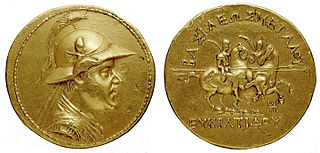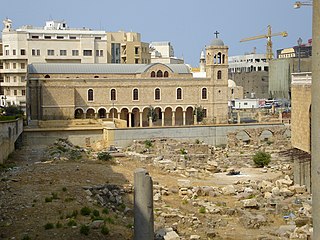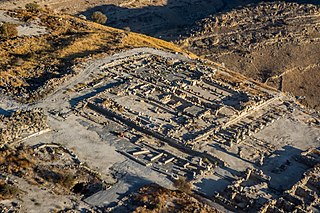 W
WAi-Khanoum, possibly the historical Alexandria on the Oxus, possibly later named Eucratidia, Εὐκρατίδεια) was one of the primary cities of the Greco-Bactrian Kingdom from circa 280 BCE, and of the Indo-Greek kings when they ruled both in Bactria and northwestern India, from the time of Demetrius I to the time of Eucratides. Previous scholars have argued that Ai Khanoum was founded in the late 4th century BC, following the conquests of Alexander the Great. Recent analysis now strongly suggests that the city was founded c. 280 BC by the Seleucid emperor Antiochus I Soter. The city is located in Takhar Province, northern Afghanistan, at the confluence of the Panj River and the Kokcha River, both tributaries of the Amu Darya, historically known as the Oxus, and at the doorstep of South Asia.
 W
WAlexandria in the Caucasus was a colony of Alexander the Great. He founded the colony at an important junction of communications in the southern foothills of the Hindu Kush mountains, in the country of the Paropamisadae.
 W
WApamea or Apameia was a Hellenistic city on the left bank of the Euphrates, opposite the famous city of Zeugma, at the end of a bridge of boats connecting the two, founded by Seleucus I Nicator. The city was rebuilt by Seleucus I. The site, once partially covered by the village of Tilmusa, Şanlıurfa Province, Turkey, is now flooded by the lake formed by the Birecik Dam.
 W
WBerytus, briefly known as Laodicea in Phoenicia or Laodicea in Canaan from the 2nd century to 64 BCE, was the ancient city of Beirut from the Hellenistic period through the Roman and Early Byzantine period/late antiquity. The city had been rebuilt by the Seleucids in the 2nd century BCE over the ruins of an older settlement centred on a Phoenician port dating back to Iron Age III and Persian periods. Berytus became a Roman colonia that would be the center of Roman presence in the eastern Mediterranean shores south of Anatolia. The veterans of two Roman legions under Augustus were established in the city, that afterward quickly became Romanized and was the only fully Latin-speaking city in the Syria-Phoenicia region until the fourth century. Although Berytus was an important city, Tyre was made the capital of the Roman province of Phoenicia. "Of the great law schools of Rome, Constantinople, and Berytus", the law school of Berytus stood "pre-eminent". The Code of Justinian was mostly created in this school.
 W
WBushehr or Bushire, also known as Bandar Bushehr, previously Beh Ardasher, Antiochia in Persis and Bukht Ardashir, is the capital city of Bushehr Province, Iran. At the 2006 census, its population was 161,674, in 40,771 families.
 W
WCharax Spasinu, also called Charax Spasinou, Charax Pasinu, Spasinu Charax, Alexandria or Antiochia in Susiana, was an ancient port at the head of the Persian Gulf, and the capital of the ancient kingdom of Characene.
 W
WCyrrhus is a city in ancient Syria founded by Seleucus Nicator, one of Alexander the Great's generals. Other names for the city include Hagioupolis, Nebi Huri, Khoros. A false etymology of the sixth century connects it to Cyrus, king of Persia due to the resemblance of the names. The former Roman/Byzantine (arch)bishopric is now a double Catholic titular see.
 W
WThe Decapolis was a group of ten cities on the eastern frontier of the Roman Empire in the southeastern Levant in the first centuries BC and AD. They formed a group because of their language, culture, location, and political status, with each functioning as an autonomous city-state dependent on Rome. They are sometimes described as a league of cities, although some scholars believe that they were never formally organized as a political unit.
 W
WHippos is an archaeological site in Israel, located on a hill overlooking the Sea of Galilee. Between the 3rd century BCE and the 7th century CE, Hippos was the site of a Greco-Roman city, which declined under Muslim rule and was abandoned after an earthquake in 749. Besides the fortified city itself, Hippos controlled two port facilities on the lake and an area of the surrounding countryside. Hippos was part of the Decapolis, or Ten Cities, a region in Roman Jordan, Syria and Israel that were culturally tied more closely to Greece and Rome than to the Semitic ethnoi around.
 W
WLaodicea ad Libanum, also transliterated as Laodiceia or Laodikeia; also Cabrosa, Scabrosa and Cabiosa Laodiceia – was an ancient Hellenistic city on the Orontes in Coele-Syria, the remains of which are found approximately 25 km southwest of Homs, Syria. The city is mentioned by Strabo as the commencement of the Marsyas Campus, which extended along the west side of the Orontes, near its source. It is called Cabiosa Laodiceia by Ptolemy, and gives its name to a district Laodicene (Laodikênê), in which he places two other towns, Paradisus (Paradeisos) and Jabruda (Iabmouda). Pliny, among other people of Syria, reckons ad orientem Laodicenos, qui ad Libanum cognominantur.
 W
WLaodicea was a port city and an important colonia of the Roman Empire in ancient Syria, located near the modern city of Latakia. It was also called Laodicea in Syria or Laodicea ad mare. For a short period of time under Septimius Severus, it became the capital of Roman Syria, and subsequently, it became the capital of the Eastern Roman province of Theodorias from 528 AD until 637 AD.
 W
WLatakia is the principal port city of Syria, as well as the capital of the Latakia Governorate. Historically, it has also been known as Laodicea in Syria or Laodicea ad Mare. In addition to serving as a port, the city is a manufacturing center for surrounding agricultural towns and villages. According to the 2004 official census, the population of the city is 383,786, Its population greatly increased as a result of the ongoing Syrian Civil War due to the influx of refugees from rebel held areas. It is the 4th-largest city in Syria after Aleppo, Damascus and Homs, and it borders Tartus to the south, Hama to the east, and Idlib to the north while Cape Apostolos Andreas, the most north-eastern tip of Cyprus is about 68 miles (109 km) away.
 W
WNahavand is a city and capital of Nahavand County, Hamadan Province, Iran. At the 2006 census, its population was 72,218, in 19,419 families. It is located south of Hamadan, east of Malayer and northwest of Borujerd. Occupied since prehistoric times, Nahavand was bestowed upon the House of Karen in the Sasanian period. During the Arab conquest of Iran, it was the site of the famous Battle of Nahavand.
 W
WQinnasrin, also known by numerous other romanizations and originally known as Chalcis-on-Belus, was a historical town in northern Syria. The town was situated 25 km (16 mi) south west of Aleppo on the west bank of the Queiq River and was connected to Aleppo with a major road during Roman times.
 W
WShahr-e Rey or simply Ray is the capital of Ray County in Tehran Province, Iran. Formerly a distinct city, it has now been absorbed into the metropolitan area of Greater Tehran as the 20th district of municipal Tehran, the capital city of the country.
 W
WSeleucia, also known as Seleucia-on-Tigris or Seleucia on the Tigris, was a major Mesopotamian city of the Seleucid, Parthian, and Sasanian empires. It stood on the west bank of the Tigris River opposite Ctesiphon, within the present-day Baghdad Governorate in Iraq.
 W
WSeleucia-on-the-Hedyphon was an ancient city on the Hedyphon river in Susiana, east of Mesopotamia, currently the site of Ja Nishin, Khuzestan Province, Iran.
 W
WSusa was an ancient city in the lower Zagros Mountains about 250 km (160 mi) east of the Tigris River, between the Karkheh and Dez Rivers. One of the most important cities of the Ancient Near East, Susa served as the capital of Elam and the Achaemenid Empire, and remained a strategic centre during the Parthian and Sasanian periods.